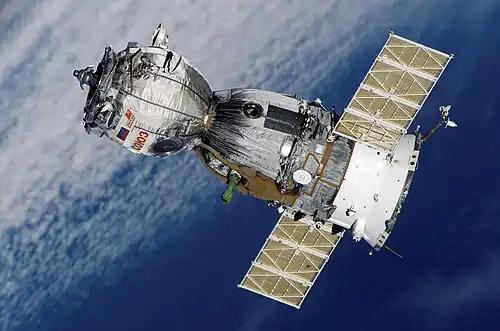Soyuz T-10
The Soyuz T-10 return capsule on display at the Nehru Planetarium in New Delhi, India | |
| Mission type | Dock with Salyut 7 |
|---|---|
| Operator | Experimental Design Bureau (OKB-1) |
| COSPAR ID | 1984-014A |
| SATCAT no. | 14701 |
| Mission duration | 62 days 22 hours 41 minutes 22 seconds |
| Spacecraft properties | |
| Spacecraft | Soyuz 7K-ST No.15L |
| Spacecraft type | Soyuz-T |
| Manufacturer | Experimental Design Bureau (OKB-1) |
| Launch mass | 6850 kg |
| Landing mass | 2800 kg |
| Crew | |
| Crew size | 3 |
| Launching | Leonid Kizim Vladimir Solovyov Oleg Atkov |
| Landing | Yuri Malyshev Gennadi Strekalov Rakesh Sharma |
| Callsign | Mayak (Beacon) |
| Start of mission | |
| Launch date | 8 February 1984, 12:07:26 UTC |
| Rocket | Soyuz-U s/n Yu15000-357 |
| Launch site | Baikonur, Site 31/6 |
| Contractor | Experimental Design Bureau (OKB-1) |
| End of mission | |
| Landing date | 11 April 1984, 10:48:48 UTC |
| Landing site | 160 km at the east of Dzhezkazgan, Kazakhstan |
| Orbital parameters | |
| Reference system | Geocentric orbit |
| Regime | Low Earth orbit |
| Perigee altitude | 199.0 km |
| Apogee altitude | 219.0 km |
| Inclination | 51.6° |
| Period | 88.7 minutes |
| Docking with Salyut 7 | |
| Docking date | 13 April 1984 |
Soyuz T-10 was the fifth expedition to the Salyut 7 space station. It entered a darkened and empty station because of the loss of Soyuz T-10a. It was visited by the sixth and seventh expeditions. During the course of the cosmonauts stay, three extravehicular activities took place to repair a fuel line.[1]
During their multiple spacewalks to perform maintenance on the station, the crew set a record for spacewalk hours.[2]
Crew
| Position | Launching Cosmonaut | Landing Cosmonaut |
|---|---|---|
| Commander | Second spaceflight |
Second and last spaceflight |
| Flight Engineer | First spaceflight |
Third spaceflight |
| Research Cosmonaut | Only spaceflight |
Only spaceflight India |
Backup crew
| Position | Cosmonaut | |
|---|---|---|
| Commander | ||
| Flight Engineer | ||
| Research Cosmonaut | ||
Mission parameters
- Mass: 6850 kg
- Perigee: 199.0 km
- Apogee: 219.0 km
- Inclination: 51.6°
- Period: 88.7 minutes
Mission highlights
Fifth expedition to Salyut 7. Visited by 6th and 7th expeditions. The three-person Mayak crew entered the darkened Salyut 7 station carrying flashlights. The cosmonauts commented on the burnt-metal odor of the drogue docking unit.[3] By 17 February 1984, Salyut 7 was fully reactivated, and the cosmonauts had settled into a routine. Physician Oleg Atkov did household chores and monitored his own health and that of his colleagues, who conducted experiments. During the previous year a fuel line on the station had ruptured. Kizim and Solovyov carried out three EVAs to try to fix the problem during the mission.
Spacecraft location
The Soyuz T-10 descent module is on display at the Nehru Planetarium in New Delhi, India, along with the spacesuit of Rakesh Sharma.[4]
References
- ^ D.S.F. Portree (1995). "Mir Hardware Heritage" (PDF). NASA. pp. 50, 97–99. Archived from the original (PDF) on 9 July 2003.
 This article incorporates text from this source, which is in the public domain.
This article incorporates text from this source, which is in the public domain.
- ^ Yenne, Bill (1988). The Pictorial History of World Spaceflight. Exeter. pp. 170, 177. ISBN 0-7917-0188-3.
- ^ "Soyuz T-10". Spacefacts.
- ^ Sharma, Priya. "Sky walk, A trip to the Nehru Planetarium". The Indian School. Retrieved 13 May 2025.
External links
